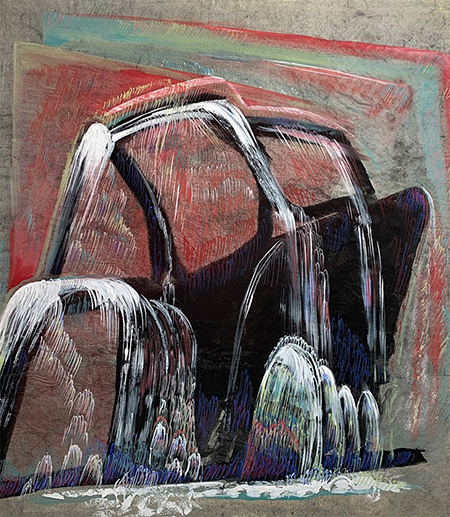
Continuing through February 24, 2024
In Heroes Gallery’s inaugural show in the Pacific Northwest, curators Harriet Salmon and Jesse Penridge pair new works by two contemporary artists, Letha Wilson and Mariah Robertson, with two works by the late Morris Graves, one of the defining figures of the Northwest Mystics movement.
The gallery began during the pandemic as a virtual exhibition space, bringing together historical work and works by contemporary artists. Salmon and Penridge were based in New York prior to their recent move to Seattle, and rather than immediately opening up their own brick-and-mortar, they have joined forces for the year with studio e and its founder, Dawna Holloway, with shows from the two curatorial programs alternating throughout 2024.
A historically prominent artist like Morris Graves helps grab the attention of a local audience unfamiliar with Robertson or Wilson. But beyond that, Graves’ life and legacy seems especially relevant at this time. The two works in the show were painted not long after spending eleven months in prison as a conscientious objector to the draft during World War II. He was released only after being deemed mentally unfit for service. Graves assiduously documented the natural world, often focusing on its most overlooked elements, from details of plants and creatures to the unseen infiltration of the natural world by “Machine Age Noise.” Graves was a true pacifist, opting out of the industrialized modern world that sustains itself through violence against the wilderness and other peoples.
The Covid-19 pandemic forced on us all a disconnection from and re-evaluation of that world. Some barely survived it, while others were surprised by how much they enjoyed it. People took themselves outside more, but not without cost to those natural spaces, already overrun by tourists who typically focus on the grandiose the panoramic, not the minute and unseen that Graves called to our attention.
In that light, the works of Wilson and Robertson don’t seem aesthetic and conceptual successors to Graves, at least at first glance, so viewers expecting a direct genealogy may be disappointed. Further, Graves was neither a photographer nor interested in photorealism, whereas Wilson and Robertson use photographic processes as the starting point of their works. However, there are through lines among the three artists, and they lead to some gratifying insights.
An artist is not necessarily a mystic, and a mystic is not necessarily a hermit, but Graves was all three. The mystic is not defined by the actions they undertake, but by the state of grace in which they live that finds unity in all things. An artist’s work may reveal connections between what appears discrete, or even ineffable and unattainable, in ways that can emphasize unity or disunity. And the hermit may physically, emotionally and intellectually distance themselves from the designed world of humanity, merely out of disgust, or out of a more gracious desire to cleave more closely to the ineffable via the natural world.
Robertson communes via the darkroom. However, her works do not begin from a photographic image. They are more akin to action painting, using developing chemicals to create abstract works from the pure chemistry and flow of the liquids. Their vivid spontaneity becomes more dimensional as Robertson arranges the cut pieces onto white backgrounds, allowing the paper to curl and be separated by bands of negative space. Visually, her three pieces form a close rhyme with Graves’ paintings of pale waterfalls.
If one balks at the comparison between Robertson’s aleatory abstraction and Graves’ dutiful expressionism, one should keep in mind that the map is not the territory. Graves was no more capturing nature than is Robertson, and this tension between the artistic document and the landscape is especially evident in Wilson’s works. At an artist talk, Wilson spoke to the frustration she felt as a photographer early on, knowing what it was actually like to be in a landscape versus the photographic “fragments” that are left alongside our memory.
Rather than leaving it at those fragments, Wilson uses photos as raw material to create sculptural works on steel and cement. The photographic emulsion is transferred onto blobs of concrete in works like “Hudson Valley Washington Concrete Bend,” which combines various foliage into linear bands, giving us nothing that resembles a landscape at all, or even a botanical study, but rather an ambiguous fusion of that created and natural world.
Her folded paper prints do less to disrupt the images of foliage and stone, but because of the sharpness of their structure and the narrow sections laser cut from them. The natural forms visually fade further into the background, despite covering every surface of the object.
That may be an apt metaphor for how our so-called separation from the natural world is really just an intellectual trick. We are never not in nature, and always bound by its laws, its tendency toward equilibrium, which we ignore at our peril. The supposed tension between the natural and the artificial is more about our own instinctive awareness that we are collectively not being the best stewards, to the detriment of others, animals as well as people, and ultimately ourselves.
Graves may rightly be called an Ardent Mystic, because he fully lived his principles in a certain state of grace which was inseparable from both art and nature. For fans of Graves, we are given a novel lens to re-engage with his ideas and beliefs, rather than resorting to a rehearsed hagiography. Meanwhile, we are invited to get a deeper read of Wilson’s and Robertson’s works where we otherwise might stop with the novel forms and processes alone.
